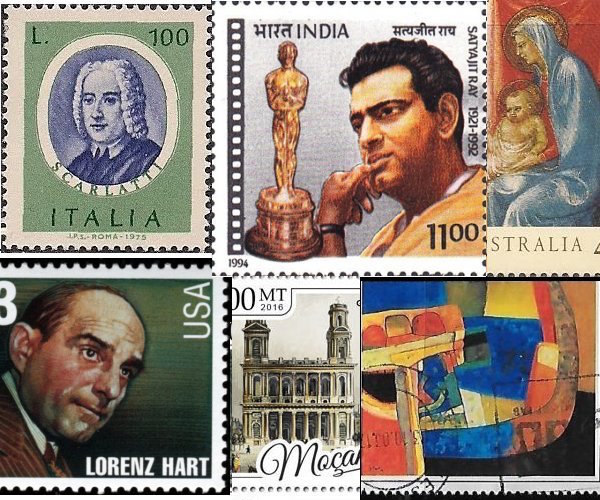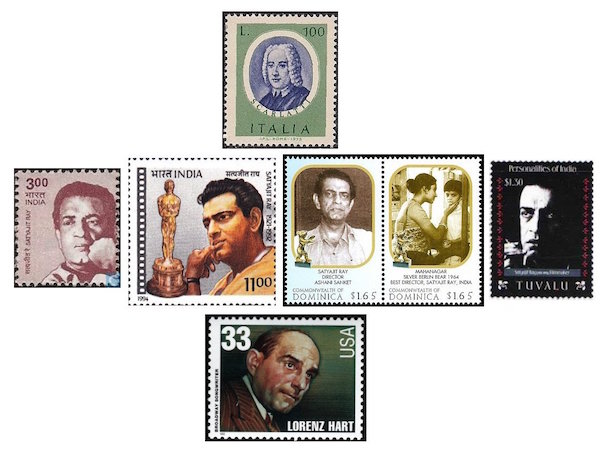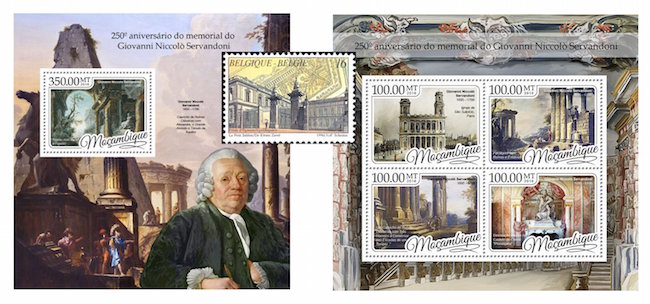The Arts on the Stamps of the World — May 2
An Arts Fuse regular feature: the arts on stamps of the world.

By Doug Briscoe
I think our three biggest names today are Alessandro Scarlatti, Satyajit Ray, and Lorenz Hart; we’ll also acknowledge the birthdays of 18th-century French artist Jean-Nicolas Servan, Austrian operetta composer Carl Ziehrer, French painter Maurice Estève, and Kazakh opera singer Kulyash Baiseitova, and the death date (in 1430) of Italian painter Giovanni Francesco Toscani.
Today is the birthday of Alessandro Scarlatti, not to be confused with his son Domenico, who wrote all the harpsichord sonatas; but Alessandro (2 May 1660 – 22 October 1725) was no slacker, either: he composed about 500 chamber cantatas in addition to his stage works and sacred music. And he was productive in another way: Domenico was not his only composing son—there was another named Pietro Filippo Scarlatti.
I imagine Satyajit Ray (SUT-ya-jit RYE; 2 May 1921 – 23 April 1992) is the most familiar Indian filmmaker to Westerners, besides being the greatest. His family had been one of distinction for generations. His father and grandfather were literary men, and Ray himself would become a polymath in literature, art, music and, of course, film. He began as a commercial artist, then designed book covers, and in 1947 co-founded the Calcutta Film Society (for the screening, not the making, of films). He met Jean Renoir when the French director came to Calcutta to work on The River. That meeting and a viewing of Vittorio De Sica’s Bicycle Thieves (1948) fixed Ray’s determination to work in the medium. Besides his three dozen films, Ray wrote not only screenplays and essays on film but children’s literature, composed music for his films, designed type faces, and was fascinated by intellectual puzzles, chess, and Western classical music. In addition to the (expected) stamps from India, there is a pair from Dominica congratulating Ray on winning Berlin’s Silver Bear for Best Director for Mahanagar (1964) and a stamp from Tuvalu. He received an honorary Oscar for lifetime achievement just prior to his death a week or so before his 71st birthday.

Lyricist Lorenz Hart (May 2, 1895 – November 22, 1943) most famously paired with composer Richard Rodgers. They met in 1919 and worked together on 26 Broadway musicals, including Babes in Arms, Pal Joey, and On Your Toes, and on several films. Some of their biggest hit songs were “Bewitched, Bothered, and Bewildered”, “Blue Moon”, “My Funny Valentine”, and “The Lady Is a Tramp”. Hart was a lifelong sufferer from depression, which was aggravated by a self-loathing of his height and appearance, his homosexuality, and the death of his mother. He sought oblivion in alcohol and died of pneumonia following a drinking bout at the age of 48.
Jean-Nicolas Servan (2 May 1695 – 19 January 1766) is also known as Giovanni Niccolò Servandoni, because he was born in Florence and studied in Rome. He also worked for a time as a set designer at London’s new Royal Academy of Music before going to Paris in 1724, where he served as director of decorations at the Paris Opera for eighteen years, all the while producing paintings (he made a specialty of trompe-l’œil effects), working as an architect, and designing fireworks displays! As a builder he created the facade of Saint-Sulpice in Paris and three palaces in Belgium, among them Egmont Palace in Brussels, which we can see on a Belgian stamp of 1996. Somewhat to my surprise there is no French stamp showing Saint-Sulpice, but it appears on one of the stamps (at upper left) in the second of the two souvenir sheets from Mozambique. The first sheet has as its backdrop Caprice of Ruins With Alexander the Great, while the stamp itself presents Ruins With Cows and Figures. On the second sheet, at upper right is Landscape With Ruins and Statues; at bottom left is Caprice of Classical Ruins With Three Men Talking, while the final stamp of the group shows a rendering of Servan’s design for one of the interiors at the Château de Condé in Aisne. (The statue that is the centerpiece of the design is François Girardon’s Rape of Proserpine by Pluto, which is in the gardens at Versailles.)

For three days in a row now we’ve had birthdays (and stamps, of course) for composers of operetta. Today it’s the Austrian Carl Michael Ziehrer (May 2, 1843 – November 14, 1922), also known for his rivalry with the Strauss family and his 600 waltzes, polkas, and marches.
At the age of nine, Maurice Estève (2 May 1904 – 29 June 2001) went with his parents from his native town of Culan (smack dab in the center of France) to Paris. There his visits to the Louvre found him particularly enamored of the works of Jean Fouquet and Paolo Uccello, though he soon adopted a sort of Cubist Fauvism and then turned away from realism altogether. He had a one-man show in 1930 and collaborated with Robert Delaunay on panels for the 1937 Paris International Exhibition. Estève also worked in collage and textile design. He was 97 when he expired in his birthplace of Culan. The stamp from 1986 shows us his Skibet (1979).
Kazakh’s first professional opera singer Kulyash Baiseitova was thought to have been born on May 2nd in 1912 in Almaty, the largest city in today’s Kazakhstan. At 17 she was working at the Kazakh Drama Theater, and four years later (1933) she made a success in the première of the Aiman-Sholpan, a musical treatment of a Kazakh epic. Soon she was being called the Kazakh Nightingale. Baiseitova took part in the staging of the first Kazakh opera Kyz Zhibek (1934) by Yevgeny Brusilovsky. She died aged 45 on 6 June 1957 in Moscow. In Kazakhstan an opera house, a music school, a competition, and a street in Almaty are all named for her.

That’s all for today’s birthday people, but we conclude with an artist who died on this date. Not much is known about Giovanni Francesco Toscani (1372 – 2 May 1430). He was student of Giottino (Tommaso di Stefano) and was at one time a member of the guild of artists in Florence, where most of his surviving work can be found today. The Metropolitan Museum in New York has his Crucifixion (c1472-30), formerly attributed only to the anonymous Master of the Griggs Crucifixion. The stamps show Toscani’s Adoration of the Magi (c1427-30), which is housed at the National Gallery of Victoria in Melbourne, Australia.
I continue to be surprised at the philatelic neglect of the German poet known as Novalis (né Georg Philipp Friedrich Freiherr von Hardenberg; 1772 – March 25, 1801), whose work was set by so many important composers, including Schubert, Mahler, and Hindemith.
A graduate of the University of Massachusetts with a B.A. in English, Doug Briscoe worked in Boston classical music radio, at WCRB, WGBH, and WBUR, for about 25 years, beginning in 1977. He has the curious distinction of having succeeded Robert J. Lurtsema twice, first as host of WGBH’s weekday morning classical music program in 1993, then as host of the weekend program when Robert J.’s health failed in 2000. Doug also wrote liner notes for several of the late Gunther Schuller’s GM Recordings releases as well as program notes for the Boston Classical Orchestra. For the past few years he’s been posting a Facebook “blog” of classical music on stamps of the world, which has now been expanded to encompass all the arts for The Arts Fuse.
